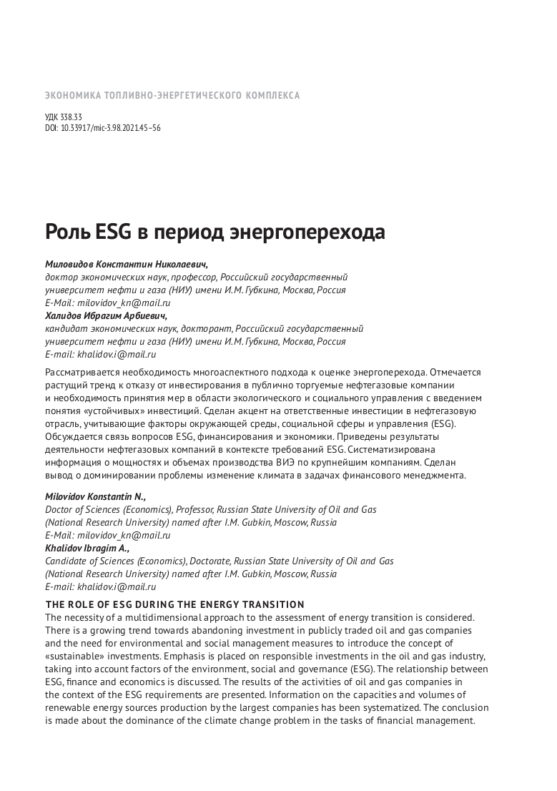The role of ESG during the energy transition
DOI: 10.33917/mic-3.98.2021.45-56
The necessity of a multidimensional approach to the assessment of energy transition is considered. There is a growing trend towards abandoning investment in publicly traded oil and gas companies and the need for environmental and social management measures to introduce the concept of “sustainable” investments. Emphasis is placed on responsible investments in the oil and gas industry, taking into account factors of the environment, social and governance (ESG). The relationship between ESG, finance and economics is discussed. The results of the activities of oil and gas companies in the context of the ESG requirements are presented. Information on the capacities and volumes of renewable energy sources production by the largest companies has been systematized. The conclusion is made about the dominance of the climate change problem in the tasks of financial management.
References:
1. Fishman, Alanna. 2020. ESG in Oil and Gas: Engaging in the Market Evolution. OGEL 5 (2020), in Environmental, Social and Governance (ESG). [Electronic resource]. – Access mode: https://www.ogel.org/article.asp?key=3919 (accessed: 17.05.2021).
2. Virtual University. Responsible Investment in Oil & Gas. A case for Environmental, Social, Governance (ESG). Business, Energy, Environment. [Electronic resource]. – Access mode: https://www.bluewaterpe.com/esg (accessed: 17.05.2021).
3. Haley Zaremba. 2020. Why Shale Executives Should Jump On The ESG Trend Now. Oil price, August 27, 2020. [Electronic resource]. – Access mode: https://oilprice.com/Energy/Energy-General/Why-Shale-Executives-Should-Jump-On-The-ESG-Trend-Now.html (accessed: 19.05.2021).
4. Renzi Stone. 2019. How Will Environmental Social Governance (ESG) Impact Oil and Gas? [Electronic resource]. – Access mode: https://convergetechmedia.com/environmental-social-governance/ (accessed: 19.05.2021).
5. Judy Feder. 2020. ESG and Energy Transition. Balancing Value and Values in a Post-Pandemic World. [Electronic resource]. – Access mode: https://jpt.spe.org/esg-and-energy-transition-balancing-value-and-values-post-pandemic-world (accessed: 21.05.2021).
6. Lindsay Delevingne, Anna Gründler, Sean Kane. 2020. The ESG premium: New perspectives on value and performance. McKinsey. Strategy & Corporate Finance and Sustainability Practices, February 2020. [Electronic resource]. – Access mode: https://www.mckinsey.com/business-functions/sustainability/our-insights/the-esg-premium-new-perspectives-on-value-and-performance (accessed: 21.05.2021).
7. Witold Henisz, Tim Koller, Robin Nuttall. 2019. Five ways that ESG creates value. McKinsey Quarterly, November 2019. [Electronic resource]. – Access mode: https://www.mckinsey.com/business-functions/strategy-and-corporate-finance/our-insights/five-ways-that-esg-creates-value (accessed: 23.05.2021).
8. Mauricio Cárdenas, Juan José Guzmán Ayala, J. Nicolas Hernandez-Aguilera. 2020. Boosting ESG finance for the post-COVID-19 world. Sipa, April 22, 2020. [Electronic resource]. – Access mode: https://energypolicy.columbia.edu/sites/default/files/file-uploads/BoostingESGFinancePost-COVID_CGEP_Commentary_042220-3.pdf (accessed: 23.05.2021).



